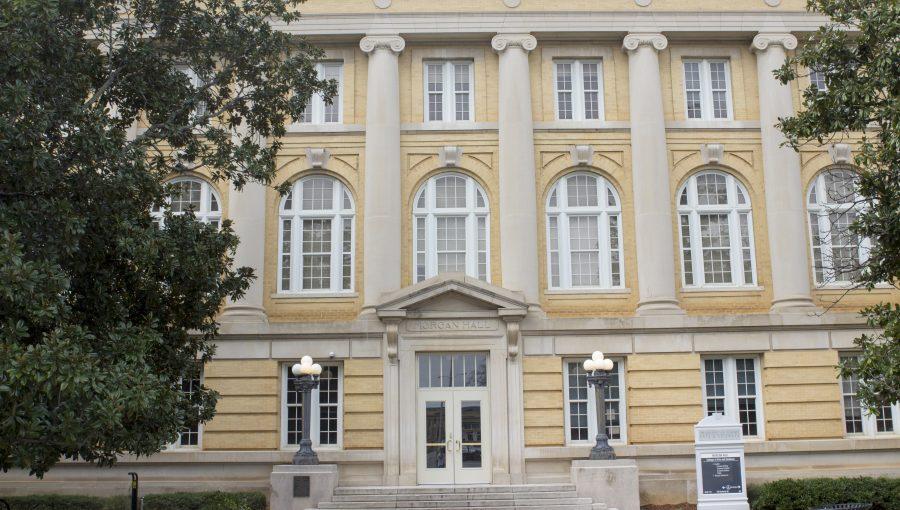After 105 years, University of Alabama students are banding together and petitioning to change the name of the English department building, demanding it be changed to a more appropriate name – specifically after “To Kill a Mockingbird” author Harper Lee. Feb. 19, the day that UA alumna Lee died, was the day a UA student saw an opportunity to take something tragic and turn it around. It was the day she launched a petition on change.org demanding President Stuart Bell change Morgan Hall to Lee Hall.
“It’s appalling to me that students of color have to walk around buildings named after people who wouldn’t have wanted them to get an education and might have even wanted to harm them,” said Jessica Hauger, a senior majoring in history and anthropology who started the petition. “We have so many amazing people who went to this University, why not name a building like Morgan Hall after Harper Lee instead of some KKK Dragon?”
Hauger started the petition around noon and by 4 p.m. on Friday, the online petition had 347 supporters. By 11:50 p.m. that night, the number had risen to 1,027 supporters. The student activist group We Are Done, which is calling for a more inclusive and equitable campus, shared the petition, showing support for the change.
Morgan Hall was dedicated in 1911 to previous Alabama senator John Tyler Morgan, who was also the primary reason the University was rebuilt after Union troops destroyed the campus. According to a commemorative plaque inside the building, he was named “for his high character and great qualities of head and heart,” but students are now challenging this dedication, questioning why a man known as “one of the most outspoken white supremacists of the early Jim Crow Era,” a man who actively supported an emigration policy to deport all African-Americans, represents a UA campus building.
Morgan isn’t the only building; several are named after white supremacists, KKK members, eugenicists, pro-slavery advocates and vocal racists. Some UA faculty members said every few years, students seem to struggle with the issue, yet nothing has changed. As more and more students discover the darker parts of the people immortalized on the campus buildings, it raises the question about who are the people behind the names and if they are worthy to be such a fundamental part of the University.
For Hauger, the answer is no. After the Charleston shooting and the controversy over removing the confederate flag this past summer, she said felt like she should speak about pieces of University history she found disturbing.
“I think this is a crucial moment in the campaign to change the names of these buildings,” Hauger said. “Public support is necessary for the change and Harper Lee is such a well-loved figure who deserves this honor. She puts the legacy of John Tyler Morgan in perspective.”
For Dana Sweeney, a junior majoring in English, this is the chance to honor someone who has had a “profound” cultural impact in the last century. He said it makes sense to have the building housing the English department named after an author, especially one as influential as Lee.
He knew the history behind Morgan for a few years as he had discovered the history behind Nott Hall, which led him to reevaluate the buildings he enters daily. He said he feels like these building names continue to honor people that don’t deserve respect today, and that naming a building after someone is celebrating who they were.
“I don’t think it’s so much about wallpapering over the past as it is transcending the parts of the past that we aren’t particularly proud of,” Sweeney said. “This is feels like such an appropriate and positive way to move forward.”
Over the summer, Hauger started independently advocating for building name changes for places like Morgan, Manly and Nott Hall. After hearing a lecture on Josiah Nott’s contributions to eugenics about two years ago, Hauger started looking into the legacies of other people commemorated on campus and found information by looking online.
John Tyler Morgan was a slave owner; Basil Manly was the second president of the University and not only had his own slaves on campus, but believed them to be a God-given right; Josiah Nott was one of seven founders of the Alabama Medical Board but supported polygenism, meaning that humans were separate species. He also used science to support racism.
Hauger said she took her complaints to the arts and sciences’ dean’s office and felt dismissed in a meeting with Lisa Lindquist-Dorr, associate dean and associate professor of history. The dean had talked about the value in keeping the names to avoid erasing history and how there was nothing they could really do about it. Hauger said she felt alone and frustrated with the resignation of the administration to disregard the issue.
“I think there’s a difference between erasing history and glorifying the past,” Hauger said.
Lindquist-Dorr said she agreed it shouldn’t be a way to honor these men, but she stressed the importance of opening dialogue about why these men were valued in their times, why they’re not now and how society has changed. She said Morgan was a “monster” but was the reason the campus had been rebuilt.
“It’s not useful to erase them and make them invisible,” Lindquist-Dorr said.
With all that is piled on the administration faculty’s plates, Lindquist-Dorr explained something like building name changes are put on the backburner. She described a long process that ultimately involves the Board of Trustees to change the name, and said there isn’t enough student interest to push the case.
“No matter who we put on buildings, we will not represent everybody the way we want,” Lindquist-Dorr said. “I think they deserve to be remembered, not necessarily to be honored. They deserve to take their place in time.”
One occurrence of history taking its place was the removal of a portrait of Morgan that faced the Hall’s main entrance. Joel Brouwer, the chair of the English department, said the removal was done to make way for the Paul R. Jones collection, which was donated to the University under stipulations it would be displayed on campus and includes work by various African-American artists. Brouwer said the Department showed interest in housing a piece of the gallery.
“I think that having work from the Jones collection displayed in Morgan Hall is a welcome way of demonstrating the department’s interest in inclusion,” Brouwer said. “I’m glad the department can help fulfill the University’s obligation.”
Sweeney said he was happy to see the massive portrait retired to the Hoole Special Collections Library. He said the wall space is hard to ignore walking into the building, so getting to see something reflecting the diversity on campus is a step in the right direction.
“I didn’t feel [the Morgan portrait] deserved such a place of honor,” Sweeney said. “I think the new painting is a reminder of the progress taking place.”
While Hauger said had worked individually to make progress on building name changes, the student activist organization We Are Done included in its 11 demands it issued in November to either change building names associated with active racists, or put up plaques telling of this aspect of their history.
Amanda Bennett, a senior majoring in English and African-American studies and a co-organizer for We Are Done, said she thinks it’s important to engage with history “in full.” While she said she may personally prefer a building name change, Bennett sees the importance in showcasing how history can be manipulated, and how slavery and racism were a part of the past that needs to be recognized.
“There are still these very prominent ghosts and specters of racism and violence and segregation that permeate this entire campus,” Bennett said. “So it makes it psychologically and emotionally difficult for at least more than one student to have to deal with that every single day as they walk to classes while also facing direct actions of racism and microaggression from other students as well.”
She said it’s like the history supporting the actions of the present, as students undergo racism and still feel discriminated against.
Bennett also stressed the importance of discussion about these issues on campus instead of covering them up or keeping a “skewed” portrayal of the campus’ history. Looking at the plaques the University currently has in place, she said it’s a falsified portrayal of the history. She said if these names are going to remain on campus, she wants to see a full acknowledgement of horrors of the past to help educate people in 2016.
“Education is critical,” Bennett said. “We really have not grappled the conversation on race in a way that is conducive to long-term change.”
After the petition went online, Bennett showed complete support for the change of Morgan Hall.
“By recognizing the achievements of alumni such as Harper Lee, we are gradually progressing to a point in our university’s history where we value the courage and integrity of the myriad of individuals who have committed their lives to improving Alabama,” Bennett said in an email correspondence.
This issue becomes a debate about how to outweigh the good someone did with the bad, but it isn’t an excuse for apathy and inaction, she said. She wants to see people who can represent all different spheres of life engraved on building names, from people of different ethnic backgrounds to women to LGBTQ+ people.
“These men did good for who?” Bennett said. “They were racists, rapists and sexists. I think we have to ask ourselves, who are we prioritizing? Who do we value? We have the potential to incorporate other narratives.”
Erik Peterson, assistant professor of history of science, argues another man did not have a great enough legacy to earn him a place above a doorway on campus.
“Josiah Nott is an important figure – but for exactly the wrong reasons,” Peterson said. “All the other people on campus that we don’t like, they all were racists. Nott wasn’t just a racist. What Nott said is that there is a scientific argument why slavery should be permanent and why humans did not descend from the same ancestors.”
Nott worked to prove racism and slavery through science. According to Peterson’s research for an upcoming interdisciplinary book on evolution in Alabama, Nott’s logic was used to justify treating natives in Jamaica or New Zealand like livestock.
Nott was quoted, saying: “The negro achieves his greatest perfection, physical and moral, and also greatest longevity, in a state of slavery.”
At least one hundred people have commented on the petition vocalizing their support. Many are current UA students, many are alumni, some have never attended the University and some are from around the world. Even with the focus on Morgan Hall, people are also expressing their desire to stop honoring people like Nott.
“While it is important to remember our past, we shouldn’t commemorate people who were associated with causes that existed to harm and suppress other individuals,” said Caitlyn Walker in a supporter comment on change.org. “There are several other notable people from Alabama who would be more deserving of this honor.”
The exact reason Nott Hall is named after him isn’t very clear. From what Peterson found in the Board of Trustee notes from 1922, there wasn’t much reason behind the decision besides that someone suggested it, and then they confirmed the vote.
Peterson said Nott had been dead for 40 years when the building was named, and he had never set foot on the campus. It was the medical building at the time, which is how he could have been possibly linked to. Otherwise, other prominent figures on campus seemed to support his ideas. Manly, who also has a building on campus named for him, signed a pamphlet from a talk Nott gave entitled “An essay on the natural history of mankind viewed in connection to negro slavery.” The talk argued that slavery was the only condition Africans can live under, and if they were allowed to rule themselves, everything would return to chaos.
“As a mixed African-American and Caucasian female, it’s very disheartening to witness and go to places that still hold such strong ties to the ideas and values of segregation,” said Talia Ulrich, a current UA student, in a comment on the petition.
Nott is credited for starting the first medical school in Mobile, but Peterson said he found that previously enslaved men were allowed on that campus, Nott became furious and left the state, saying that New York was better because “it had less free men and less rules than Alabama.” Nott is often credited for working on yellow fever and advancing the research on the disease. Still today, there is still no cure, and Peterson said Nott just wrote a handful of articles that didn’t add much knowledge.
While there may be a merited debate behind buildings like Morgan, Peterson said Nott Hall stands out because it’s named after a man with no connection to the University. According to Peterson’s research, Nott didn’t fight for the confederacy, he didn’t have a clue about yellow fever and really can only be attributed to making racism a scientific argument.
Peterson also said he doesn’t think that students care that much about what buildings are named, but as the petition circulated among students this weekend, support has risen from hundreds to thousands within hours.
The petition has increased visibility on other buildings on campus. For Byron Solomon, a junior majoring in history, the petition raised the issue, why not rename Nott Hall too? As a student in Peterson’s history of science class, two weeks ago Solomon discovered these facts about Nott and said he felt responsible as a history major to discover the truths of this man honored on campus.
He said he feels that the University is known for two things: football and racism. Keeping a man’s name like Nott on campus, he said, is hindering the University going in a new direction and creating an inclusive future. He said a building is just a building, but the stigma around the name and history of it can impact students on campus.
“I don’t think you can ever erase the past,” Solomon said. “Changing the name of a building isn’t forgetting about the past. It’s more just taking down the symbol of something that happened.”
Something that strikes Peterson, he said, is the double standard in using tradition as a justification in keeping the names. Not letting people of color on the football team was once a tradition, he said, and the University wouldn’t have as many National Championships if it hadn’t changed. Yet building names have remained the same to uphold tradition.
“We’re perfectly comfortable getting rid of some traditions, so I don’t understand why the names of buildings are things that we hold on to,” Peterson said.
A summer ago, Hauger said she couldn’t find any support for the change she felt necessary to feel proud of her University. Only one day after she created her petition, she had found over 1,500 supporters. In the words of the famed Harper Lee, “Real courage is when you know you’re licked before you begin, but you begin anyway and see it through no matter what.” Regardless of whether the building name gets changed to Lee Hall, the call for change is a stand by UA students that Harper Lee would hopefully be proud to call “real courage.”







